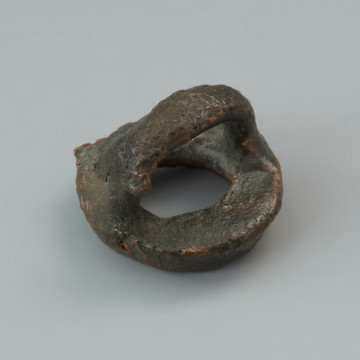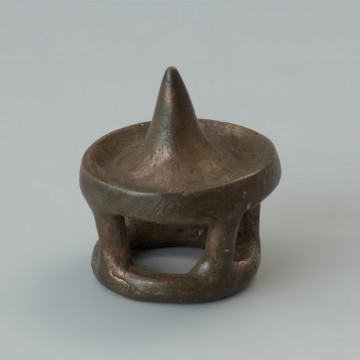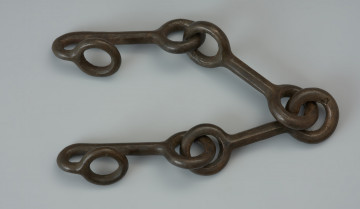
A rim button
around 750 p.n.e. — 550 p.n.e.
National Museum in Szczecin
Part of the collection: Bronze Age
The crescent-shaped razor was made from a wide bronze sheet. On both sides, at the same heights, there is a zigzag motif symbolising water. This ornament was made with a very original stitch, the so-called vibration one, consisting of tiny lines. The razor is part of a unique deposit found in a swamp in 1884. It contains rare or even unique objects: parts of a horse row, moulds for casting axes, fibulae, a razor and fragments of some bronze and iron products. The marshy context of the hoard should be emphasised, which may indicate its special significance related to beliefs and sacrificial offerings. The deposit ended up in the museum collection in Szczecin and was kept there until August 1944. Due to the approaching front and Allied air raids, it was transported deep into Germany. It only returned to Szczecin in 2009 as part of the Polish-German exchange of old archaeological collections. The artefacts from the Kiełpino hoard, dated to the Hallstatt C period (approx. 750-600/550 BC), are characteristic of the products of the Hallstatt culture, whose name derives from the cemetery in Hallstatt, Austria. The presented razor is an exception in this respect. Due to its decoration in the tremolo (vibratory) technique, it is attributed to northern Europe. Only two objects of this type are known from Poland.
Dorota Kozłowska
Author / creator
Dimensions
the entire object: height: 14 cm, width: 4 cm
Object type
razor
Technique
tremolo, repoussage, casting
Material
bronze
Origin / acquisition method
legal transfer
Creation time / dating
Creation / finding place
Owner
National Museum in Szczecin
Identification number
Location / status

around 750 p.n.e. — 550 p.n.e.
National Museum in Szczecin

around 750 p.n.e. — 550 p.n.e.
National Museum in Szczecin

around 750 p.n.e. — 550 p.n.e.
National Museum in Szczecin
DISCOVER this TOPIC
National Museum in Lublin
DISCOVER this PATH
Educational path